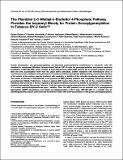Por favor, use este identificador para citar o enlazar a este item:
http://hdl.handle.net/10261/28790COMPARTIR / EXPORTAR:
 SHARE SHARE
 CORE
BASE CORE
BASE
|
|
| Visualizar otros formatos: MARC | Dublin Core | RDF | ORE | MODS | METS | DIDL | DATACITE | |

| Título: | The plastidial 2-C-methyl-D-erythritol 4-phosphate pathway provides the isoprenyl moiety for protein geranylgeranylation in tobacco BY-2 cells |
Autor: | Gerber, Esther; Hemmerlin, Andréa; Hartmann, Michael; Heintz, Dimitri; Hartmann, Marie-Andrée; Mutterer, Jerome; Rodríguez Concepción, Manuel; Boronat, Albert CSIC ORCID; Van Dorsselaer, Alain; Rohmer, Michel; Crowell, Dring N.; Bach, Thomas J. | Fecha de publicación: | 9-ene-2009 | Editor: | American Society of Plant Physiologists | Citación: | Plant Cell 21(1): 285-300 (2009) | Resumen: | Protein farnesylation and geranylgeranylation are important posttranslational modifications in eukaryotic cells. We visualized in transformed Nicotiana tabacum Bright Yellow-2 (BY-2) cells the geranylgeranylation and plasma membrane localization of GFP-BD-CVIL, which consists of green fluorescent protein (GFP) fused to the C-terminal polybasic domain (BD) and CVIL isoprenylation motif from the Oryza sativa calmodulin, CaM61. Treatment with fosmidomycin (Fos) or oxoclomazone (OC), inhibitors of the plastidial 2-C-methyl-d-erythritol 4-phosphate (MEP) pathway, caused mislocalization of the protein to the nucleus, whereas treatment with mevinolin, an inhibitor of the cytosolic mevalonate pathway, did not. The nuclear localization of GFP-BD-CVIL in the presence of MEP pathway inhibitors was completely reversed by all-trans-geranylgeraniol (GGol). Furthermore, 1-deoxy-d-xylulose (DX) reversed the effects of OC, but not Fos, consistent with the hypothesis that OC blocks 1-deoxy-d-xylulose 5-phosphate synthesis, whereas Fos inhibits its conversion to 2-C-methyl-d-erythritol 4-phosphate. By contrast, GGol and DX did not rescue the nuclear mislocalization of GFP-BD-CVIL in the presence of a protein geranylgeranyltransferase type 1 inhibitor. Thus, the MEP pathway has an essential role in geranylgeranyl diphosphate (GGPP) biosynthesis and protein geranylgeranylation in BY-2 cells. GFP-BD-CVIL is a versatile tool for identifying pharmaceuticals and herbicides that interfere either with GGPP biosynthesis or with protein geranylgeranylation. | Descripción: | 17 pages, 11 figures.-- PMID: 19136647 [PubMed].-- PMCID: PMC2648074.-- Supplementay information available at: http://www.plantcell.org/cgi/content/full/tpc.108.063248/DC1 | Versión del editor: | http://dx.doi.org/10.1105/tpc.108.063248 | URI: | http://hdl.handle.net/10261/28790 | DOI: | 10.1105/tpc.108.063248 | ISSN: | 1040-4651 | E-ISSN: | 1532-298X |
| Aparece en las colecciones: | (IQAC) Artículos |
Ficheros en este ítem:
| Fichero | Descripción | Tamaño | Formato | |
|---|---|---|---|---|
| Gerber_Esther_et_al.pdf | 1,3 MB | Adobe PDF |  Visualizar/Abrir |
CORE Recommender
PubMed Central
Citations
13
checked on 20-abr-2024
SCOPUSTM
Citations
45
checked on 13-abr-2024
WEB OF SCIENCETM
Citations
41
checked on 23-feb-2024
Page view(s)
344
checked on 19-abr-2024
Download(s)
300
checked on 19-abr-2024
Google ScholarTM
Check
Altmetric
Altmetric
Artículos relacionados:
NOTA: Los ítems de Digital.CSIC están protegidos por copyright, con todos los derechos reservados, a menos que se indique lo contrario.
